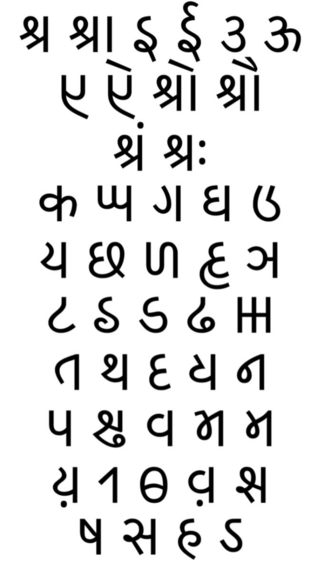Top Qs
Timeline
Chat
Perspective
Kaithi
Historical script used in Awadh and Bihar regions of India From Wikipedia, the free encyclopedia
Remove ads
Kaithi (𑂍𑂶𑂟𑂲, IPA: [kəɪ̯t̪ʰiː]), also called Kayathi (𑂍𑂨𑂟𑂲), Kayasthi (𑂍𑂰𑂨𑂮𑂹𑂟𑂲, IPA: [kəjəst̪ʰiː]), Kayastani, or Kaite Lipi (काइते लिपि) in Nepali,[1] is a Brahmic script historically used across parts of Northern and Eastern India. It was prevalent in regions corresponding to modern-day Uttar Pradesh, Bihar, and Jharkhand. The script was primarily utilized for legal, administrative, and private records and was adapted for a variety of Indo-Aryan languages, including Angika, Awadhi, Bhojpuri, Hindustani, Maithili, Magahi, and Nagpuri.[2]


Remove ads
Etymology
The name Kaithi script is derived from the term Kayastha, a socio-professional group historically linked to writing, record-keeping and administration.[3] This community served in royal courts and later in British colonial administration, maintaining revenue records, legal documents, title deeds, and general correspondence.[4] The script they utilized was thus named Kaithi, reflecting their association with written documentation.[citation needed]
Remove ads
History
Summarize
Perspective


Documents in Kaithi are traceable to at least the 16th century. The script was widely used during the Mughal period. In the 1880s, during the British Raj, the script was recognised as the official script of the law courts of Bihar. Kaithi was the most widely used script of North India west of Bengal. In 1854, 77,368 school primers were in Kaithi script, as compared to 25,151 in Devanagari and 24,302 in Mahajani.[5] Among the three scripts widely used in the 'Hindi Belt', Kaithi was widely perceived to be neutral, as it was used by both Hindus and Muslims alike [citation needed] for day-to-day correspondence, financial and administrative activities, while Devanagari was used by Hindus and Persian script by Muslims for religious literature and education. This made Kaithi increasingly unfavorable to the more conservative and religiously inclined members of society who insisted on Devanagari-based and Persian-based transcription of Hindi dialects. As a result of their influence and due to the wide availability of Devanagari type as opposed to the incredibly large variability of Kaithi, Devanagari was promoted, particularly in the Northwest Provinces, which covers present-day Uttar Pradesh.[6]
In the late 19th century, John Nesfield in Oudh, George Campbell of Inverneill in Bihar and a committee in Bengal all advocated for the use of Kaithi script in education.[7] Many legal documents were written in Kaithi, and from 1950 to 1954 it was the official legal script of Bihar district courts. Present day Bihar courts struggle to read old Kaithi documents.[8]
Remove ads
Classes
On the basis of local variants Kaithi can be divided into three classes viz. Bhojpuri, Magahi and Trihuti.[9][10]
Bhojpuri

This was used in Bhojpuri speaking regions and was considered as the most legible style of Kaithi.[9]
Magahi
Native to Magah or Magadh it lies between Bhojpuri and Trihuti.[9]
Tirhuti
It was used in Maithili speaking regions and was considered as the most elegant style.[9]
Consonants
All Kaithi consonants have an inherent a vowel:
Remove ads
Vowels
Kaithi vowels have independent (initial) and dependent (diacritic) forms:
Diacritics

Several diacritics are employed to change the meaning of letters:
Remove ads
Vowel diacritics
Summarize
Perspective
The following table shows the list of vowel diacritics on consonants. The vowel diacritics on consonants are called kakahārā (𑂍𑂍𑂯𑂰𑂩𑂰).
Remove ads
Signs and punctuation
Kaithi has several script-specific punctuation marks:
General punctuation is also used with Kaithi:
- + plus sign can be used to mark phrase boundaries
- ‐ hyphen and - hyphen-minus can be used for hyphenation
- ⸱ word separator middle dot can be used as a word boundary (as can a hyphen)
Remove ads
Numerals
Kaithi uses stylistic variants of Devanagari numeral. It also uses common Indic number signs for fractions and unit marks.[11]

Unicode
Kaithi script was added to the Unicode Standard in October 2009 with the release of version 5.2.
The Unicode block for Kaithi is U+11080–U+110CF:
| Kaithi[1][2] Official Unicode Consortium code chart (PDF) | ||||||||||||||||
| 0 | 1 | 2 | 3 | 4 | 5 | 6 | 7 | 8 | 9 | A | B | C | D | E | F | |
| U+1108x | 𑂀 | 𑂁 | 𑂂 | 𑂃 | 𑂄 | 𑂅 | 𑂆 | 𑂇 | 𑂈 | 𑂉 | 𑂊 | 𑂋 | 𑂌 | 𑂍 | 𑂎 | 𑂏 |
| U+1109x | 𑂐 | 𑂑 | 𑂒 | 𑂓 | 𑂔 | 𑂕 | 𑂖 | 𑂗 | 𑂘 | 𑂙 | 𑂚 | 𑂛 | 𑂜 | 𑂝 | 𑂞 | 𑂟 |
| U+110Ax | 𑂠 | 𑂡 | 𑂢 | 𑂣 | 𑂤 | 𑂥 | 𑂦 | 𑂧 | 𑂨 | 𑂩 | 𑂪 | 𑂫 | 𑂬 | 𑂭 | 𑂮 | 𑂯 |
| U+110Bx | 𑂰 | 𑂱 | 𑂲 | 𑂳 | 𑂴 | 𑂵 | 𑂶 | 𑂷 | 𑂸 | 𑂹 | 𑂺 | 𑂻 | 𑂼 | | 𑂾 | 𑂿 |
| U+110Cx | 𑃀 | 𑃁 | 𑃂 | | ||||||||||||
| Notes | ||||||||||||||||
Remove ads
Publications
The first Bhojpuri quarterly Bagsar Samāchar was published in this script in 1915.[12]
See also
References
Wikiwand - on
Seamless Wikipedia browsing. On steroids.
Remove ads

